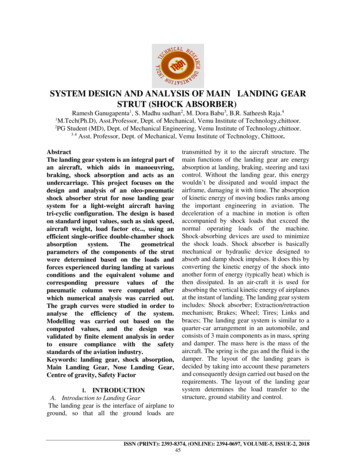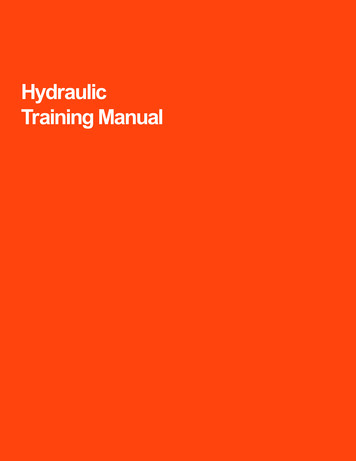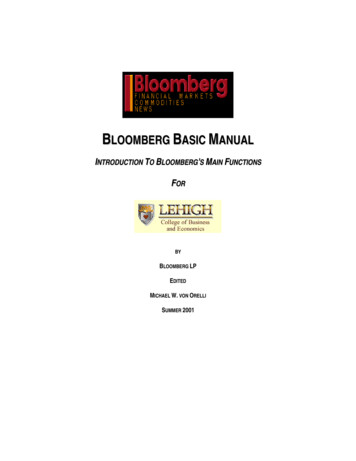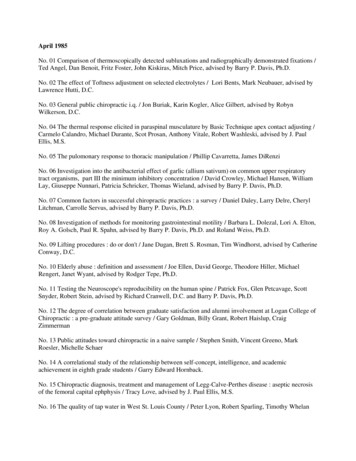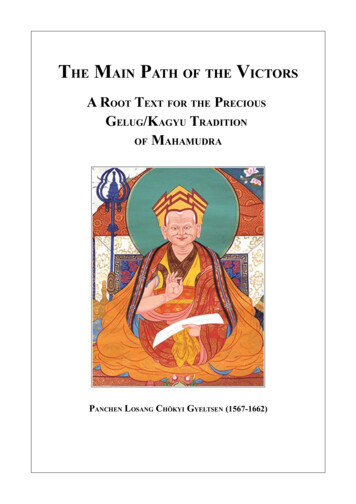
Transcription
THE MAIN PATH OF THE VICTORSA ROOT TEXT FOR THE PRECIOUSGELUG/KAGYU TRADITIONOF MAHAMUDRAPANCHEN LOSANG CHÖKYI GYELTSEN (1567-1662)
Gelug/Kagyu Tradition of MahamudraHere, in explaining the instructions on Mahamudra from the tradition of the holy beings who are scholarsand adepts, there are three outlines:1) activities for entering into the composition,2) actual explanation of the composed instructions and3) dedication of virtue arisen through having composed the instructions.1. Activities for entering into the compositionNAMO MAHAMUDRAYAI respectfully bow at the feet of my peerless guru, master of adepts, who directly exposed the great sealof Mahamudra, the all-pervasive nature of everything, the indivisible, inexpressible and indestructiblesphere of the mind.I shall now write down instructions on Mahamudra coming from the Gelug/Kagyu tradition of thesupreme adept Dharmavajra and his spiritual sons, a tradition of excellent instructions havinggathered the essence of the ocean of sutras, tantras and oral instructions.2. Actual explanation of the composed instructionsRegarding this, there are three outlines:1) preliminaries,2) actual practice and3) conclusion.2A. PreliminariesIn order to have a doorway for entering into the Dharma and a central pillar for the Mahayana,sincerely go for refuge and generate bodhicitta, without these being merely words from your mouth.In general, as a preliminary to giving any profound instructions or engaging in meditation, all the holy beingsof the different traditions in Tibet concord in doing what is called "The Four Guiding Instructions":1) Going for refuge and generating bodhicitta,2) Vajrasattva meditation,3) Mandala offering and4) Guru yoga.And in particular, having first meditated on loving-kindness, compassion, bodhicitta, renunciation, karma,death and impermanence, the supreme disciple of highest yoga tantra, the lord of yogis, Milarepa also gaveadvice saying:Being very afraid of the eight states of non-leisureI meditated on impermanence and the disadvantages of samsara,Meticulously followed the principles of karma, the law of cause and effect andConstantly entrusted myself to the three jewels of refuge.Having trained my mental continuum in the method of bodhicittaI cut the continuum of the obscurations and their latenciesAnd realized that all appearances are like illusions.I am now without any fear of the three lower realms.Similarly, as said by the great vajradhara Dragpa Gyeltsen in Parting from the Four Attachments:If there is attachment to this life, you are not a dharma practitioner.If there is attachment to samsara, you do not have renunciation.1
Gelug/Kagyu Tradition of MahamudraIf there is attachment to self-interest, you do not have bodhicitta.If there is grasping, you do not have the correct view.Thus:1) as an antidote to attachment to this life, it is necessary to train in the practices of the initial capacityperson such as reflecting on the freedoms and opportunities, impermanence and the sufferings of thelower realms,2) as an antidote to attachment to samsara, it is necessary to train in the three higher trainings havingunderstood that all of samsara is in the nature of suffering,3) as an antidote to seeking peace and happiness for oneself alone, cultivate loving-kindness,compassion and bodhicitta, and4) as an antidote to the self-grasping that is the root of samsara, it is necessary to meditate on theselflessness of person and phenomena.Since in their treatises on authentic sutras and tantras, every Indian and Tibetan scholar and adept praisedthose paths highly, do not think that they are merely preliminaries, even though they have been explained inthe context of the preliminaries, but rather practice them by integrating them into your actual practice.Moreover, since seeing the ultimate nature of the mind is dependent upon having accumulated thecollections and purified the obscurations, recite the hundred-syllable mantra of Vajrasattva at least ahundred thousand times, and in addition, as an essential practice, earnestly confess negative actions andpromise to refrain from doing them again by completing the four opponent powers, through practices such asmaking as many hundreds of prostrations as possible while reciting The Admission of Downfalls.Then, from the depths of your heart, make repeated requests to your root guru who is kind in threeways, seeing them as inseparable from all the past, present and future Buddhas or as the essence of theThree Jewels combined.2B. Actual practiceEven though there are many ways of approaching Mahamudra, they can all be classified as either1) Sutra Mahamudra or2) Tantra Mahamudra.Here I will explain the first one rather extensively, and since the latter one will be presented using very fewwords, I will explain that first.2B1. Tantra MahamudraFurthermore, why is it called "Mahamudra"?As said in the Drop of Mahamudra:"mu" is the primordial wisdom of emptiness."dra" is the liberation from the phenomena of samsara."maha" is the union.This describes "Mahamudra".Tantra Mahamudra refers to the clear light mind that is the primordial wisdom of co-emergent greatbliss arisen through the entering, abiding and dissolving of the winds into the central channel due to skilfulmethods such as penetrating the vital points of the subtle vajra body. This is dependent upon havingreceived the four pure empowerments, having properly guarded the commitments and vows, and havingfamiliarized oneself with the generation stage.2
Gelug/Kagyu Tradition of MahamudraWhen such a primordial wisdom realizes emptiness by way of a generic image it is a similitude clear light,and when it realizes emptiness directly, it is the actual clear light. The clear light mind is taught using suchterms as "definitive meaning short AH", "indestructible drop", "uncontrived mind", "ordinary mind" and"primordial mind".It is the Mahamudra accepted by Saraha, Nagarjuna, Naropa and Maitripa. It is the innermostessence of the anuttarayoga class of tantra and is the principal subject matter taught in The SevenAccomplishment texts and in Saraha's Three Cycles of Dohas.As said [by Sahara] in the Dohas:By engaging in emptiness devoid of compassionYou will not find the supreme path.Alternatively if you just cultivate compassionYou will remain here in samsara and will not attain liberation.Whoever is able to conjoin those twoWill not abide in samsara and will not abide in nirvana.Therefore it is necessary to join the subject – compassion which is the co-emergent great bliss – with theobject – emptiness.As for generating the realization of this Mahamudra, if the winds enter, abide and dissolve in the centralchannel through having trained in the preceding paths in previous lives or in the earlier part of this life, thensuch a person can actualize the clear light Mahamudra by observing any suitable object, like settling themind in a non-conceptual state. Previous Kagyu masters gave this person the name "the simultaneous one".For all other trainees it is definitely necessary to meditate on tummo and so forth in order to actualize theMahamudra of this path. Accordingly, with respect to meditating on the Mahamudra indicated here, it isnecessary to obtain the four pure empowerments and to train in the generation stage, the completion stage,the common paths and so forth. Such a person is given the name "the serial one". Thus, even most of thegreat adepts of this path entered into the lineage of empowerment of the various classes of anuttarayogatantras.2B2. Sutra MahamudraSutra Mahamudra refers to the ways of meditating on emptiness as directly indicated in the ThreeMothers – the extensive, middling and brief Perfection of Wisdom Sutras. As said by the supremeArya Nagarjuna:There is no path to liberation other than this.Here I shall give instructions on Mahamudra in accordance with his thought, and describe ways tointroduce the nature of the mind in accordance with the instructions of the lineage masters.Why is that which is taught here called "Mahamudra"?As said in The King of Concentrations Sutra:The nature of all phenomena is a seal.In that way, since emptiness is the nature of all phenomena it is a seal (mudra). And since when it is realizedone is liberated from all degenerations, it is great or supreme (maha).There are many lineages of practice each one having their own unique name, such as The Co-emergent Union [Karma Kagyu], The Amulet Box [Shangpa Kagyu],3
Gelug/Kagyu Tradition of Mahamudra The Five Parts [Drikung Kagyu],The Six Cycles of Equal Taste [Drugpa Kagyu],The Four Syllables [Maitripa],The Pacifier [Padampa Sangye],Chod – The Object to be Cut Off [Machig Labdron],Dzogchen – The Great Perfection [Nyingma],Instructions on The Madhyamaka View [Gelug] and so forth.However, when investigated by a yogi learned in definitive meaning scriptures, skilled in logicalreasoning and experienced in meditation, they all come down to the same intended meaning.This being the case, from among the two approaches within Sutra Mahamudra,1) seeking to meditate after having gained the correct view and2) seeking the correct view after having meditated,here I shall explain in accordance with the latter approach.Now it is true that there are the two different approaches, however the approach of seeking the correct viewafter having meditated, is in accordance with that said by the Protector Shantideva:Vipashyana endowed with shamathaCompletely destroys the afflictions.Knowing this, first seek shamatha.And also said in the Pile of Jewels Sutra:Through abiding in ethics, concentration is attained.Having attained concentration, cultivate wisdom.This being the case, what is the method for initially cultivating shamatha?2B2A. ShamathaRegarding this, there are two outlines:1) preparation and2) actual practice.2B2A-1. PreparationAs said by Je Maitreya:The place where the intelligent practiceIs a place with easy access, a safe place,A place with good ground and good friends,And the requisites for yogic practice.It is explained that while remaining in such a place, it is necessary to rely on the prerequisites for shamathaby abiding in pure ethics, having few desires, being content and so forth, and it is definitely necessary to dothe six preparatory practices.On a seat comfortable for concentration, assume the sevenfold bodily posture and clear out anyimpure breath with the nine-round [breathing exercise]. Having refined the awareness, then begin witha virtuous pure mind by going for refuge and generating bodhicitta. Cultivate the profound path ofguru yoga and then, after making hundreds of very strong fervent requests, dissolve the guru intoyourself.4
Gelug/Kagyu Tradition of Mahamudra2B2A-2. Actual practiceThe concentration to be accomplished here is a concentration possessing two aspects:1) vivid clarity and2) a non-discursive single-pointedness.Such an authentic shamatha arises from a single-pointed concentration of the desire realm of one who has thebasis of a non-equipoised mind. As said by the Protector Maitreya:It arises from its causes. Relying on applyingThe eight antidotes to abandon the five faults.Thus it is taught that shamatha is accomplished through the nine mental abidings, arising from applying theeight antidotes to abandon the five faults. Moreover, in his treatises on the grounds, Arya Asanga states thatthe nine mental abidings are accomplished by the six powers and the four mental engagements.Through focusing on what type of object of meditation does one cultivate concentration?Although the Bhagavan taught that, in general, there are countless objects that are a suitable basis foraccomplishing faultless concentration, since most of the previous gurus of these instructions accept focusingon the mind, here also this very method will be used.Within that state of fleeting appearances, do not modify anything with discursive thoughts such ashopes thinking about accomplishing certain goals, or fears concerned about whether or not certainundesirable things will eventuate. Without wavering, that is without dwelling in the past, withoutanticipating the future and without moving around in the present, settle in meditative equipoise within thatstate for a short while.When settling the mind in this way it is not that you stop your attention like when fainting or fallingasleep. Rather, station the guard of non-forgetful mindfulness so that the mind that is unwaveringly stilldoes not become distracted. In that way the observed object is bound by the rope of mindfulness. Ifhowever, mindfulness degenerates, there will be a great danger of the proliferation of thoughts that will movethe mind. Therefore, it is necessary to set up introspection like a watcher to be aware of whether or not themind is moving elsewhere, due to the strength of mindfulness having become weak. As said in[Bhavaviveka's] Heart of the Middle Way:The elephant of the mind that is out of controlIs to be bound with certainty by the rope of mindfulnessTo the firm post of the observed objectAnd gradually brought under control by the hook of introspection.In brief, accomplishing faultless concentration does not go beyond the manner of sustaining mindfulness andintrospection. Furthermore, mindfulness is principal, and if this is present then introspection, which is said tobe the result of mindfulness, comes naturally.Now attentively focus mindfulness on the mind's nature of awareness and clarity, and observe it singlepointedly and nakedly.When observing in this way, whatever thoughts arise simply recognize each one. Such a technique reliesupon introspection. Or alternatively, just like the swordsman's battle with the archer taught in the Vinayascriptures, having generated strong mindfulness and introspection, as soon as any thought arises cut it offcompletely, not allowing it to continue.5
Gelug/Kagyu Tradition of MahamudraWhen the proliferation of thoughts has been finally severed and you are unwaveringly still, then withoutlosi
In general, as a preliminary to giving any profound instructions or engaging in meditation, all the holy beings of the different traditions in Tibet concord in doing what is called "The Four Guiding Instructions": 1) Going for refuge and generating bodhicitta, 2) Vajrasattva meditation, 3) Mandala offering and 4) Guru yoga. And in particular, having first meditated on loving-kindness .




